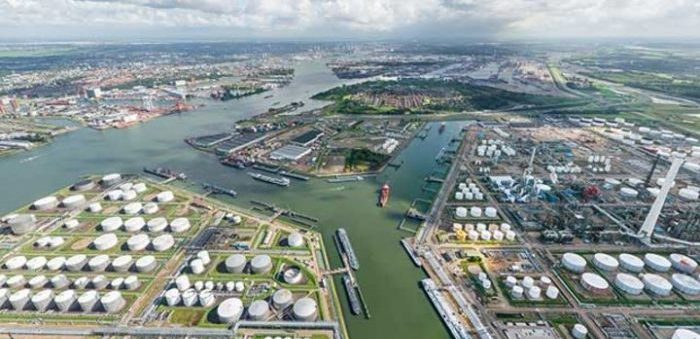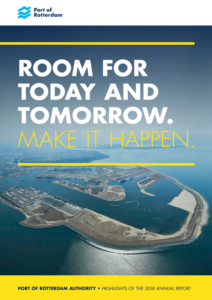The Port of Rotterdam published its annual report for 2018, noting that its total throughput grew 0.3% in 2018. In addition, container throughput, measured in TEUs, increased by 5.7%. This increase makes the Port capable of pursuing new initiatives regarding energy transition and digitisation.
Port Rotterdam’s total throughput rose by 0.3% in 2018, with its container throughput, measured in TEUs, growing by 5.7%. Moreover, the net operating result rose slightly to €254.1 million, mainly due to lower interest charges. This result made the Port able to continue investing in the current port and industrial area and develop new initiatives in the area of energy transition and digitisation.
[smlsubform prepend=”GET THE SAFETY4SEA IN YOUR INBOX!” showname=false emailtxt=”” emailholder=”Enter your email address” showsubmit=true submittxt=”Submit” jsthanks=false thankyou=”Thank you for subscribing to our mailing list”]
Moreover, the report says that the Port of Rotterdam contributes €45.6 billion to gross domestic product. Namely, about 1.2 million people live in and around the port, and the port directly and indirectly employs 385,000 people in the Netherlands.
A healthy and attractive living environment for local residents and employees in the port is important for creating economic and social value
the Port highlighted.
Furthermore, its gross investments grew 91% to €408.1 million in 2018, which is the highest level since the construction of Maasvlakte 2. The vast majority of this amount was used to improve the logistical accessibility of the port of Rotterdam, for example by starting construction of the Container Exchange Route and building the Princess Amalia Viaduct.
The Port is also cooperating with partners to make the handling of shipping traffic more efficient. For this reason, during 2018, it launched Pronto, the digital app that reduces ships’ waiting times by 20%. In 2018 the Port also bought a minority stake in the port of Pecém in Brazil. The plan is to develop this port into a self-sufficient, increasingly sustainable and profitable complex. To achieve that, it will provide Pecém with the necessary expertise and financial and other resources.
In addition, The Port of Rotterdam took action in June 2018 after the Bow Jubail oil spill in the Third Petroleum Port, limiting the negative effects for business and the environment. However, cyber-security was another focal point, as last year it launched the Port Cyber Notification Desk, to which large-scale IT disruptions are reported. This measure contributes to digital resilience and security in the port of Rotterdam.
Finally, the report ‘Three steps to a sustainable Rotterdam-Moerdijk industry cluster’, published in 2018, aimed to contribute in the achievement of the Port’s ambition of being a leader in the energy transition. Meanwhile, it made progress in preparing several projects, such as the use of residual heat and the capture, transport and storage of CO2 under the North Sea. The Port is also working on digitisation in order to make trade flows more efficient.
Commenting on the report, Allard Castelein, CEO of the Port of Rotterdam Authority, stated:
Our world is changing rapidly and profoundly. Global developments such as the energy and raw materials transition, digitisation and changing goods flows have far-reaching consequences for all our activities. Flexibility and adaptability are therefore required in the further development and renewal of the Rotterdam port and industrial area. To maintain prosperity in our region, the Netherlands and Northwest Europe, we must create sufficient space for developments today and tomorrow. Our strategy therefore primarily focuses on innovative capacity, broadening the portfolio and enhancing the business climate
See more details in the PDF herebelow































































